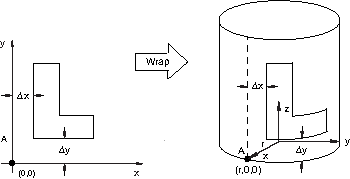Wrapping a mesh about the Z-axis | |||||||
|
| ||||||
The wrapping procedure will relocate a node at point (, ) on the planar mesh to (), where is the specified radius, = , and =, as shown in Figure 1. A point on the planar orphan mesh located at (0, 0) is mapped to location (, 0, 0) on the cylindrical surface.

Because only part instances can be positioned and only parts can be wrapped, if you want to create an instance of an orphan mesh that is wrapped and oriented properly in the assembly, some planning is required. The following steps will help you achieve the desired goal:
-
Use the tools in the Assembly module to translate and/or rotate an instance of the planar orphan mesh in the assembly.
-
Use the Create Mesh Part tool in the Mesh module to create a planar mesh part from the reoriented instance.
-
Wrap the reoriented mesh part.
-
Create an instance of the wrapped part, and use the tools in the Assembly module to translate and/or rotate the instance in the assembly.
If you are trying to create a full 360° wrap, discretization approximations may result in a small gap between nodes along the seam edge. You must use the merge nodes tool to stitch the seam by merging pairs of nodes into a single node; for more information, see Merging nodes.
The following shows an example of using the Abaqus Scripting Interface to wrap a mesh:
model = mdb.models['Model-1'] part = model.parts['Part-1'] part.wrapMesh(radius=5.0)
You can use the command line interface to enter Abaqus Scripting Interface commands, as described in Using the Python interpreter.